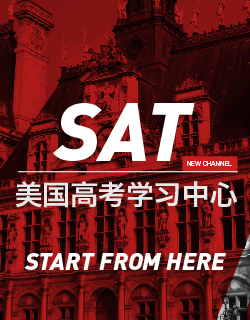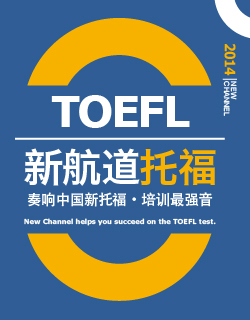SAT备考总体思路与词汇篇
网上疯传一篇SAT牛人备考经验谈,该文作者获得SAT考试满分2400, 阅读分数短期内从500飞跃到800,最终被哈佛大学录取。对此有的同学感叹:这个人真的好强!!有的同学摇头:这个人纯属吹牛,方法太玄!! 2013年,三位经我辅导的北京学生被Cornell大学录取。对比他们的成功经验,我发现这位牛人的方法可行,英语值得学习(请数数本文用了几个vouch for——证实,与attest to, verify, testify to, substantiate, certify, corroborate, warrant, validate等构成一个庞大的同义词群)。在下文中,该文的英语原文在前,我的中文点评在后。请注意英语原文的划线部分。
Do you want to learn the most infallible and least error-prone method of attacking the SAT Critical Reading Section? Learn from someone who knows. I was accepted into Harvard with a 2400 (that sounds pretentious but you should know where I'm coming from). I first have to tell you that achieving a great score on SAT CR is not easy and there's no single silver bullet. As with everything, this method requires repeated practice and experimentation before results can show. Please read on as I share with you my successful method of tackling CR.
作者:牛人背景华丽,让人羡慕妒忌恨。不过,“No pains, no gains.”
战略上要积极应对
Step 1. Let's start with the approach. You have probably encountered people in your daily life who snidely demean the SAT or at least the experience of taking the SAT. However, you must approach this important experience with a fundamentally different mindset. Okay, perhaps the SAT is a test full of tricks --- a test purely to be gamed. If so, however, learning to work within a system is a very valuable skill to have in life. Furthermore, I believe that the fundamental basis of the SAT is not its tricks, but its call for a rapid comprehension of certain situations, a supple maneuverability, and a positive approach to the material. After all, a multiple-choice test with any semblance of difficulty can be said to contain tricks. How good is your knowledge if you can't manipulate a small challenge? Don't demean your opponent - that's a recipe for disaster. The last quality, a positive approach to the material, is the most important and the one you can control the easiest. However, it does not come naturally (as can be seen with scores of grumbling teens) and takes reinforcing.
作者:战略上要积极应对——视SAT考试为机遇,而不是视其为障碍和刁难。说起来容易做起来难,但是讨厌或害怕一门考试或考试的某一项对备考极其不利。不要害怕面对自己的弱点,不要自暴自弃。认真对待才是正道。罗斯福说:“我们真正要害怕的是害怕本身”,以此重振极度绝望的美国民众的信心。在5,000年考试智慧熏陶下的中国同学一定能完胜SAT。
战术上要换位思考
Step 2. A second word about approach: You didn't pay College Board 45 bucks so that you could be nice. When you're faced with five choices on a question, you've got to be ruthless. Stop internally justifying why one answer could be right, and instead make the shift to asking yourself why that answer could be wrong - play Devil's Advocate, as clichéd as that may sound. I can't tell you enough how much this shift in thinking has helped me when I have been stuck between two seemingly correct choices. Despite appearances, all choices ARE different and one is certainly the best, or else College Board would be losing thousands of dollars to successful lawsuits. Keep this in mind. You have got to find the right answer and I will show you how.
作者:战术上要换位思考(play Devil's Advocate)——从命题人的角度分析答案的对错,思考正确选项的编写方法与错误选项的干扰陷阱。
词汇上要力求精准
Step 3. It is my intention to focus mostly on the long reading passages in this How-To, since that is where the majority of the CR questions lie and since these questions give many test-takers a higher level of grief. For sentence completions, my biggest advice is to stop wasting your time on tricks, to buckle down, and to start attacking vocabulary lists. Direct Hits is vouched for by many and proven to be most effective, though I personally usedPrinceton Review's Word Smart I and II cover to cover (perhaps not as efficient as the previously mentioned title). One problem is retention, so what I did was that I made flashcards for every word I didn't know in the book (it came out to about 1000 words). It takes a long time, but it pays off for the SAT, your reading, your writing, and your life. Only if you really know the words will you be able to confidently answer sentence completions (and consummately schmooze at cocktail parties). For the short passages, it's all about absorbing the small paragraphs as efficiently as you can before going on to answer the questions. They're considerably easier if you keep your mind, and obsessing about the short passages (going back to double or triple check) is a huge time drain. Most of the time, it's a quick fact check paired with a tone question. If you practice a lot on long passages, short passages will be an easy relief for you.
作者:词汇上要力求精准。SAT是监狱,词汇能打开它的大门。背单词的时间永远不够,所以背单词要做到:只背对的,不背累的,即集中精力背常考的核心词汇和同义词群(如上述的“证实”词群),不背几乎不考的偏僻词汇。再辅之以真题中出现的词汇的复习(请参考《SAT真词汇》),拿下高分并不难。文中提到的Princeton Review的Word Smart的上下两册不错,类似Barron’s 3, 500,有注释,有例句,还有练习,个人觉得比 Barron’s 3, 500更精准;文中提到的Direct Hits收集的词汇也比较精准。如文中所说,对于不认识的词汇,可以写在单词卡片上背诵,一面儿写英文和注释,另一面儿写中文和例句。请记住:SAT考试比耐力,更比效率,所以一定要选择最有效的备考方法。
SAT备考阅读篇
阅读上要讲方法
Step 4. Now, onto the long passages. I had loads of trouble with these before I found this method. I am going to give you my step-by-step method of attacking them, which I have found extremely effective, albeit somewhat more time-consuming. Before anything, you MUST read the short blurb before the passage. It gives you a sense (though always limited) not only of what the passage is going to be about, but also of the position and possible tone of the author. You will then be able to perhaps place yourself into the author's shoes. This is a good point right now to tell you that you MUST love the passage you are reading. Force yourself to love it - throw yourself into the passage with gusto. It works. Though it's quite ludicrous to be super-enthusiastic about a boy and his alfafa patch, with your enthusiasm comes retention, heightened focus, and an oddly vicarious interest in the passage. My general mental approach was a huge contributing factor in my getting an 800 in CR and a 2400 on the SAT.
作者:阅读上要讲方法。阅读最难,也有方法。是否有效,因人而异。第一步,阅读文章开始的斜体部分(blurb),对文章的主题、作者、段落关系有所了解。这是没错的。至于是否能像原文中说的那样与阅读文章发生恋爱关系,因人而异。以欣赏的心情去读一篇文章无疑更容易进入角色,更容易理解原文的内容。心理学研究表明,带着抵触情绪去读一篇文章肯定不利于迅速理解其内容。而且,平时的阅读情绪对个人能否持之以恒的影响很大。这和练托福阅读与托福听力如出一辙。如果讨厌原文,就很难做下去。我常常把做阅读视为增加知识、提升语言的手段。看到这样的额外好处,学习动力应该更大。
读原文要有章法
Step 5. After you have read that thrilling blurb, don't start reading the passage yet. Quickly jump to the questions, and as fast as you can, skim every question for line numberreferences (don't read the choices or the full question yet). On some passages almost every single question has a line reference - on most others it's about over half. Very rarely will you see a passage with question without any line references (perhaps only rarely on a six question passage). Anyway, once you see a line reference (In lines 23-25 of the passage, the author is saying that...), you should bracket not the lines, but the sentence contained within the lines. This mark-up will allow you to focus in on that sentence once you begin to read the passage. Based on the question, you want to make a small annotation. For this question: (In lines 23-25 of the passage, the author is saying that...), you might make the annotation MEANING next to your marked-up sentence. Other annotations might include: SAYS THIS BECAUSE, REFERS TO, HOW SIMILAR TO PASSAGE 1, BACKS UP WHAT BEFORE (think crude caveman notations - they're more efficient). Go through all of the questions. Perhaps some of the references will not have any line numbers. If you see (In the last paragraph...), just put brackets around the last paragraph along with an annotation. If you see a general question referring to the passage as a whole, on the question circle the number of the question with a large circle. This means it's a general question and must be answered AFTER all the specific questions. I find this is always a very comfortable way of attacking the questions based on how College Board writes these questions.
作者:读原文要有章法。看问题,括句子,写提示。这是看完斜体部分之后做的事情。浏览问题,不看选项,将原文对应的句子括起来,并在原文旁写下问题的类型,如问“为何这么说”、“这句话的功能是什么”等,标记要简明,如以“为什么”表示问原因等。对于涉及全文的问题,可以画圆圈,留待最后回答。是否在原文标注带行数的句子因人而异。如果选择做标注,一定要迅速完成。
阅读要讲详略
Step 6. Once you have marked up all the line references as fast as humanly possible, then the real art begins. You must read the passage. There is no way around reading every single word. But HOW you read it is the true art. Read the unmarked sections quickly yet efficiently, absorbing it briefly but not truly pausing to analyze. ONCE you hit a marked section, slow down and absorb it. If you feel that it would not disrupt your flow to answer the corresponding question, do so. If not, keep going a little more. A vast majority of the line reference questions (even complex ones such as inferences) can be answered after reading from the beginning to the point of reference. In a few instances, it may help to read past the point of reference, but NEVER read the whole passage through without pausing to answer questions. Your retention will be terrible and it's much better to handle the passage in small, manageable chunks. Also, when you answer a question, just circle in the answer in the test booklet. DO NOT BUBBLE IN THE ANSWERS UNTIL YOU FINISH THE ENTIRE PAGE, SOMETIMES EVEN THE PASSAGE. This is a huge time saver and it prevents you from making bubbling mistakes. The time saved is not necessarily the time difference in bubbling, but the time saved because it prevented you from breaking your focus. This is very important in CR. Don't break focus. If you're very low on time, however, you can bubble as you go.
作者:阅读要讲详略。真正的挑战是如何阅读原文。对于无句子标注的部分,要略读,迅速吸收意思;对于有句子标注的部分,可以读得仔细一些,而且,在不破坏阅读连贯性的前提下,同时秒杀阅读部分对应的题目。假如不太适应边读边做题,可以等读完一整段再做题。另外,每选好一个答案就在答案册上填涂一个。第一个建议可以接受,第二个建议可以接受,也可以以三个为一组填涂答案。
SAT备考答案与练习篇
答案必须对应原文
Step 7. Once you have tackled all the line and paragraph references ruthlessly, you should have already finished reading the entire passage and because you had focused in on the passage in numerous instances, you should also be well-equipped to answer your circled general questions. I always find it's easier to answer these general question at this point, seeing as how you hit up the passage numerous times already along the way. Remember to never choose an answer unless you can truly back it up with evidence from the passage. Even "inferences" do not stray far from the text. If they did, then the "best answer" would be up in the air. Do not be misled by the word "inference" - it's a misnomer. A large number of these can actually be pulled straight from the passage. It's all about the passage - not what you think or have learned thus far in school. Being one with a text and not extracting too much from it is a valuable skill to learn. Don't put words into the author's mouth. Another very helpful thing to remember when viewing the choices is that extreme choices (including the words ALWAYS, NEVER, or BEST) are rarely ever correct because they fall under the hard-to-prove category of generalization within inductive reasoning. Though you've heard this tip many times and it sounds obvious, it is so helpful (yet easy to forget) and you often find yourself internally justifying these kinds of generalizing answers. Just say no (in a ruthless yet eternally positive way).
作者:答案必须对应原文。SAT阅读命题的主要原则是“对应思维”,80%以上的问题答案都能在原文直接找到,即使是号称“推断题”(inference)的问题,它们的答案也直接对应原文或针对原文做反向思考。因此,发散性思维不适合SAT考试,对应原文才是正道。除了“对应原文”的直接做法以外,还可以排除干扰选项,如文中提到的一些含有“极端意义”的选项(如best等)。
反复练习才是王道
Step 8. My method of tackling long passages is somewhat time-consuming, but time is something that can be reduced through assiduous practice. This method is so effective in getting the right answer, and I fully vouch for it from personal experience. What I also did during practice was that I gave myself twenty minutes instead of twenty-five in the standard CR sections, and I rapidly tried to utilize my developed method. It was extremely difficult to meet the twenty-minute deadline at first but I got better and better at it through practice. While time can be addressed easily through practice, a fundamentally bad approach to the passages cannot. You should try out this method if you are having trouble with CR passages - be open. This method was THE contributing factor for my rise from a 500 to an 800 in CR. Thanks, and tell your friends about this article. Good luck!
作者:反复练习才是王道。假如选定了一个方法,可以试用,如果基本适合,就应该多练习,直至极为娴熟。当然,无论用什么方法都要根据自己的情况进行调整。真题要刷三遍。此外,如文中所说,练习时的时间要求必须比考试时严格。最理想状态是考试时一个25分钟的段落,练习时能在20分钟左右(含填涂答案时间)完成,较理想状态是22分钟完成,一般状态是24分钟完成。祝各位好运!
【敬请关注】更多内容敬请关注李传伟老师的新浪博客:哈佛SAT
相关阅读
- SAT时隔九年再爆改革 新航道专家抢先深度解读 [03-19]
- 2016年SAT考试改革(上):内容 [03-19]
- 2016年SAT考试改革(中):政策解读 [03-19]
- 2016年SAT考试改革(下):对策 [03-19]
- 哈佛硕士解密2016年SAT考试改革 [03-19]







